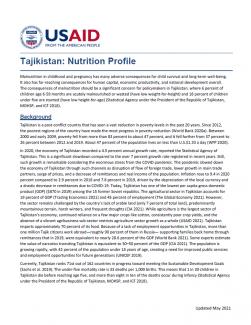Tajikistan is a post‐conflict country that has seen a vast reduction in poverty levels in the past 20 years. Since 2012, the poorest regions of the country have made the most progress in poverty reduction (World Bank 2020a). Between 2000 and early 2009, poverty fell from more than 83 percent to about 47 percent, and it fell further from 37 percent to 26 percent between 2012 and 2019. About 47 percent of the population lives on less than U.S.$1.33 a day (WFP 2020).
In 2020, the economy of Tajikistan recorded a 4.5 percent annual growth rate, reported the Statistical Agency of Tajikistan. This is a significant slowdown compared to the over 7 percent growth rate registered in recent years. Still, such growth is remarkable considering the enormous stress from the COVID pandemic. The pandemic slowed down the economy of Tajikistan through such channels as disruption of flow of foreign trade, lower growth in main trade partners, surge of prices, and a decrease of remittances and real income of the population. Inflation rose to 9.4 in 2020 percent compared to 3.9 percent in 2018 and 7.8 percent in 2019, driven by the depreciation of the local currency and a drastic decrease in remittances due to COVID‐19. Today, Tajikistan has one of the lowest per capita gross domestic product (GDP) ($870 in 2019) among the 15 former Soviet republics. The agricultural sector in Tajikistan accounts for 19 percent of GDP (Trading Economics 2021) and 45 percent of employment (The Global Economy 2021). However, the sector remains challenged by the country’s lack of arable land (only 7 percent of total land), predominantly mountainous terrain, harsh winters, and frequent droughts (CIA 2021). While agriculture is the largest sector of Tajikistan’s economy, continued reliance on a few major crops like cotton, consistently poor crop yields, and the absence of a vibrant agribusiness sub‐sector restricts agriculture sector growth as a whole (USAID 2021). Tajikistan imports approximately 70 percent of its food. Because of a lack of employment opportunities in Tajikistan, more than one million Tajik citizens work abroad—roughly 90 percent of them in Russia— supporting families back home through remittances that in 2019, were equivalent to nearly 28.6 percent of the GDP (World Bank 2021). Some experts estimate the value of narcotics transiting Tajikistan is equivalent to 30–50 percent of the GDP (CIA 2021). The population is growing rapidly, with 42 percent of the population under 18 years of age, creating a need for improved public services and employment opportunities for future generations (UNICEF 2019).
Currently, Tajikistan ranks 71st out of 162 countries in progress toward meeting the Sustainable Development Goals (Sachs et al. 2019). The under‐five mortality rate is 33 deaths per 1,000 births. This means that 1 in 30 children in Tajikistan die before reaching age five, and more than eight in ten of the deaths occur during infancy (Statistical Agency under the President of the Republic of Tajikistan, MOHSP, and ICF 2018).

